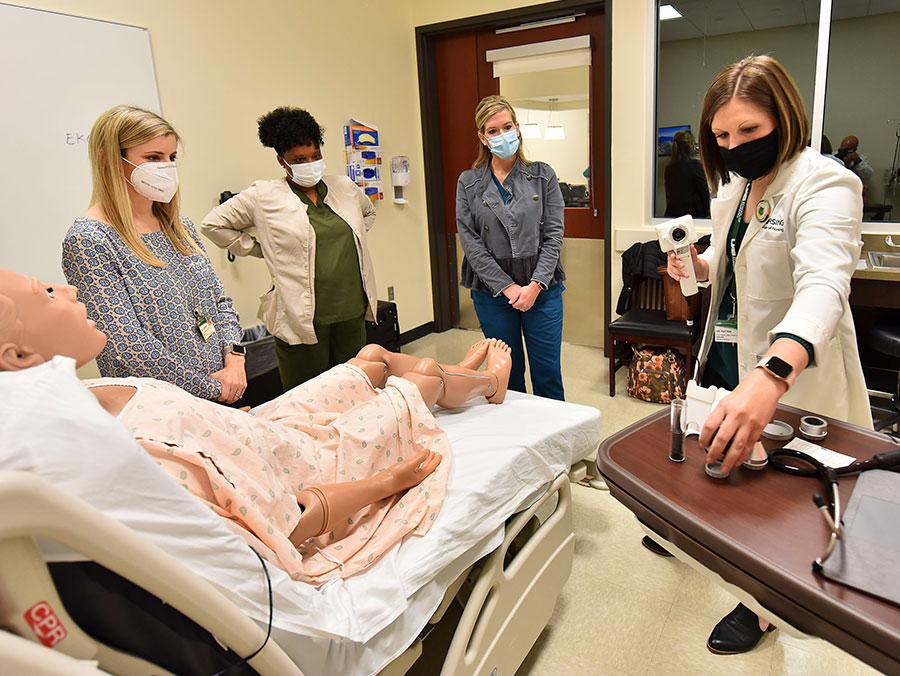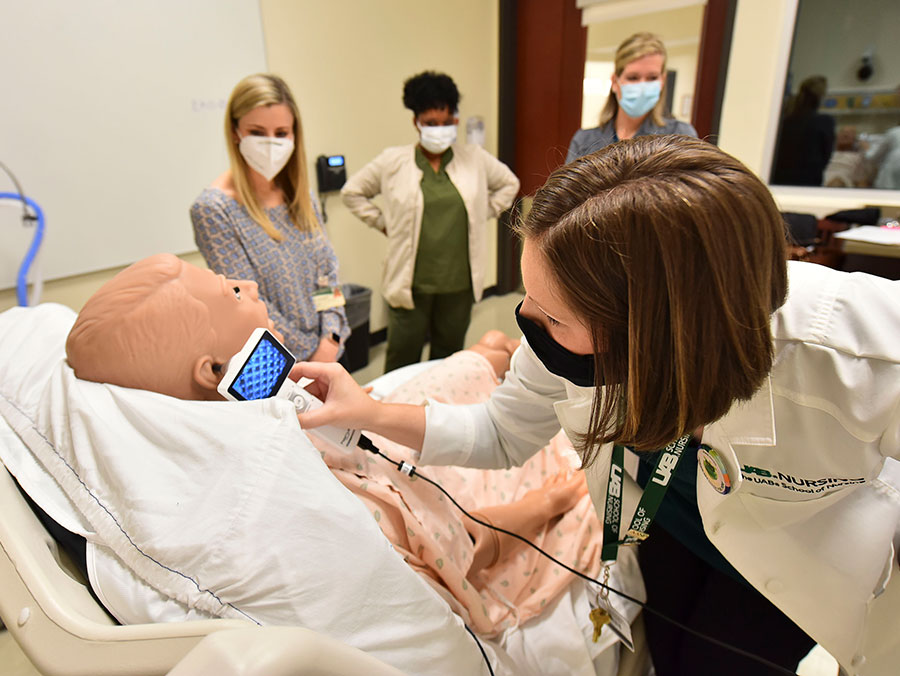 With the changes presented during the COVID-19 pandemic, telehealth has become even more important. At the UAB School of Nursing, telehealth education has long been a part of our curriculum and the COVID-19 pandemic has presented new opportunities to expand the use of telehealth for education and simulation.
With the changes presented during the COVID-19 pandemic, telehealth has become even more important. At the UAB School of Nursing, telehealth education has long been a part of our curriculum and the COVID-19 pandemic has presented new opportunities to expand the use of telehealth for education and simulation.
“Telehealth has been expanding rapidly for the last several years, as a way to deliver care especially in underserved and low-access places,” said Associate Professor of Nursing Tedra Smith, DNP, CRNP, CPNP-PC, CNE (DNP 2011, MSN 2004). “COVID-19 has emphasized the capabilities of telehealth, and emphasized its importance. It also led to new regulations and changes, and I think this has proven that you can provide effective care and quality care through telehealth. We need to prep students to be able to deliver this sort of care.”
Through a $78,000 COVID-19 CARES grant from the Health Resources Services Administration, the UAB School of Nursing under the direction of grant project director Maria Shirey, PhD, MBA, RN, NEA-BC, ANEF, FACHE, FAAN, the Jane H. Brock-Nightingale Endowed Professor and Associate Dean for Clinical and Global Partnerships, was able to further integrate telehealth into curriculum. In November 2020 through this funding, the School hosted a “COVID telehealth fair,” which was open to undergraduate and graduate students, as well as health care providers from community and UAB nurse-managed clinics.
The experience included didactic instruction through online coursework as well as an in-person simulation experience including telehealth equipment purchased through the grant, high-fidelity manikins available in our nursing competency suites, and the same telehealth platform used at UAB Hospital. The grant team faculty along with faculty in the Office of Technology and Innovation collaborated to create the virtual didactic content and facilitate the 2-day on-site experience following social distancing guidelines.
Students received not only experience during their participation, but also gained critical clinical hours through the use of telehealth.
“The availability of six clinical hours was a big selling point because, at the time in the pandemic, a lot of the clinical sites were closed,” said Shirey. “Our accrediting bodies allowed us to create clinical hours for these experiences using telehealth and simulation.”
The telehealth fair included two parts—a didactic component with distinct modules on Canvas based on the American Academy of Ambulatory Care Nursing telehealth scope and standards, and an in-person simulation using telehealth equipment at the UAB School of Nursing. The didactic portion provided information about telehealth, including the role of the nurse working within an interprofessional team in telehealth services, scope and standards of telehealth nursing practice, technical competency with the use of telehealth hardware and software, along with guidelines on data collection, interprofessional communication, and patient-centered interprofessional telehealth care with client scenarios.
The on-site simulation provided vital hands-on experience to re-enforce the didactic course content and enable students to gain telehealth proficiency in a safe and supportive setting.
 “First semester students said the experience opened their eyes to the technology, and they were able to experience things that were going on at a real practice level,” said Director of Clinical Simulation and Associate Professor Penni Watts, PhD, RN, CHSE-A. “And with telehealth, there is a lot that goes on behind the scenes. It’s having sufficient Wifi, the ability to connect to the provider, and a lot more than just technology. It’s also considering how to engage with the patient as if you are in the clinical setting.”
“First semester students said the experience opened their eyes to the technology, and they were able to experience things that were going on at a real practice level,” said Director of Clinical Simulation and Associate Professor Penni Watts, PhD, RN, CHSE-A. “And with telehealth, there is a lot that goes on behind the scenes. It’s having sufficient Wifi, the ability to connect to the provider, and a lot more than just technology. It’s also considering how to engage with the patient as if you are in the clinical setting.”
This hands-on experience is a vital part of understanding telehealth. In the telehealth setting, the care provider is in a remote setting, while an RN acting as the presenter is on-site with the patient. During the exam, the presenter must balance their interactions with the patient and the interactions with the provider, and needs to understand how to describe what they are seeing, hearing and feeling with the patients.
“For example, if a nurse palpated a finding that may be an indication of pathology, they would note it and describe it for the provider through images, video and a verbal summary,” said Instructor of Nursing Deborah Bowers, DNP, DMin, MDiv, CRNP, FNP-C. “In this situation, the nurse needs to utilize all the resources at their disposal, such as camera angles and critical questions about the patient’s symptoms, and be able to concisely summarize the information. The telehealth simulations provide an opportunity to practice and gain confidence in the use of telehealth technology and develop skills in related areas such as interprofessional communication. These competencies will support an accurate diagnosis and lead to better patient outcomes.”
Telehealth is not only an important skill for students to learn, but it is also an important mode of care for patients, especially in the COVID-19 pandemic.
“The use of telehealth in this context is important because, amidst COVID-19 concerns, there are many patients who may choose to stay home and ignore their healthcare needs. If our telehealth professionals can reach them in their homes—staying away from the waiting room and potential exposure to other patients—through telehealth, we can provide the healthcare our patients need, support their health and well-being, and avoid poor outcomes,” Bowers said.
“We are appreciative of the opportunities presented through the COVID-19 CARES grant and look forward to the launch in Summer of 2021 of a new elective course titled Concepts of Telehealth Nursing available for undergraduate and pre-licensure nursing students,” Shirey said. “Telehealth is the wave of the future and at the UAB School of Nursing, we are always thinking of ways to maximize health care delivery to reach those most in need of care.”
